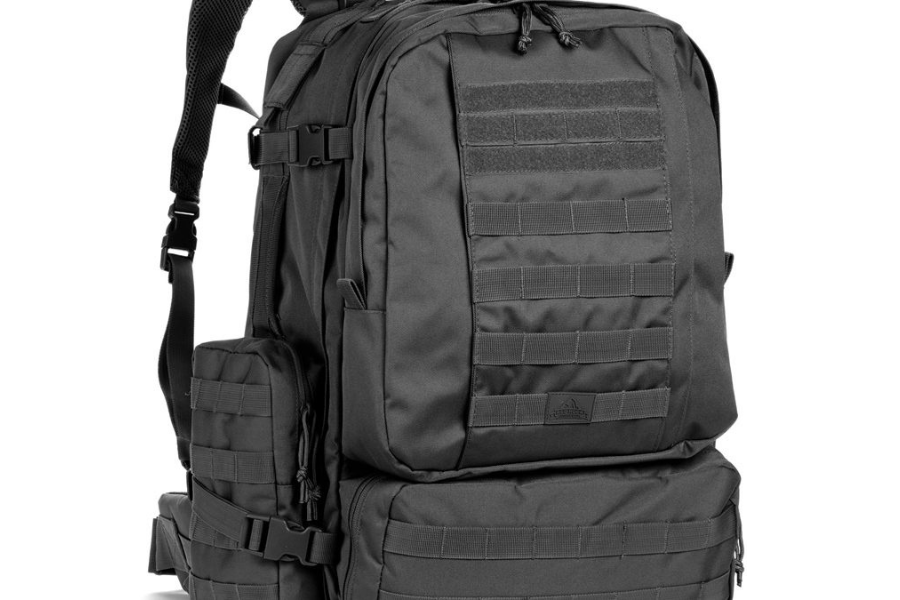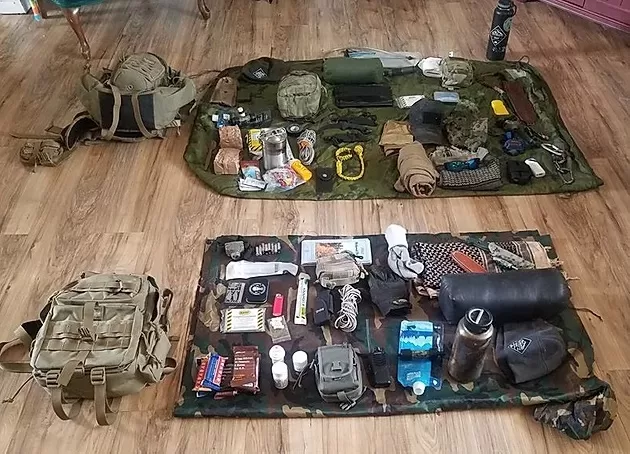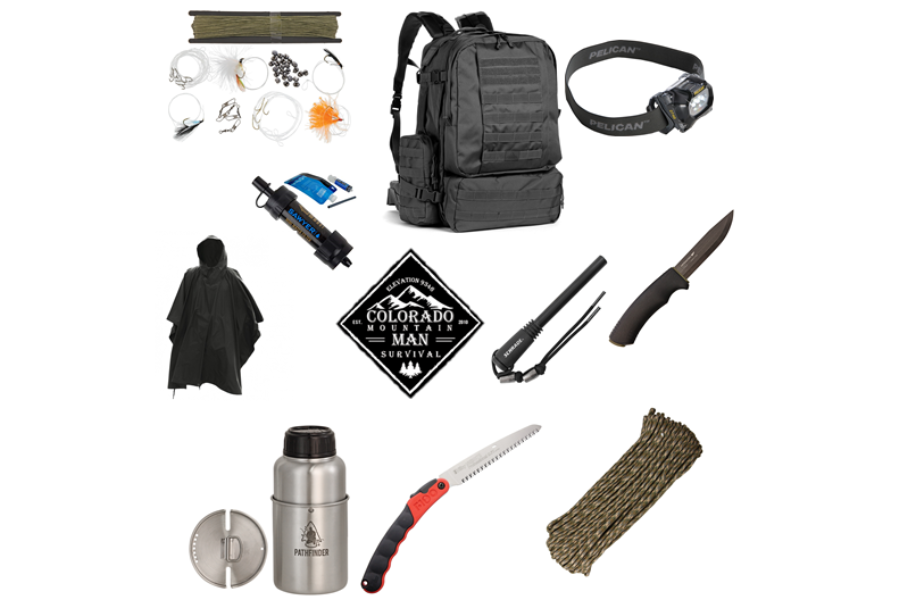Get Home Bag / Survival Kit
With the events happening around Coronavirus (covid-19), I have been asked to give an inventory of my Survival Kit or Get Home Bag. I no longer have...

Many factors come into play when you are building a bug out bag. First thing you need to consider are your physical limitations. How heavy of a load can you carry for a long distance? Guidelines used by backpackers are that a person in average physical condition should be able to carry about 20% of their body weight. That means a 200lb person can carry a a 40 lb pack. If you are in good shape, a person should be able to carry 25% of their body weight. If you are in excellent shape and well-conditioned, you can can carry 35% of their body weight.
Where are you bugging out to? Do you have a predetermined location? Do you have supplies at that location already? The very first step in building your bug out bag is making a plan. Your plan is very important and very unique to you. Assuming you have a plan, you can start putting together your bug out bag per the guidelines below, eliminating items that don’t fit your plan or physical limitations.
First things first, when putting together a bug out bag, you need… a backpack. Now, if you never intend to bug out for whatever reason and will “bug in” you can skip this part. If you are a fan of my page though, you are interested in being prepared; therefore you are still going to need many of the items that I list later on in this article. Just put these items in a good waterproof container and place it in whatever room you will be retreating to in an emergency. This may be your basement, your bathroom, or a storm cellar… just think of the safest place in your home that you would go to should a tornado strike and put it there.
Back to the backpack. You are going to need something durable, comfortable and large enough to hold all of your gear. I think a lot of people skimp here and I think this is a very bad idea. Your survival kit is going to become a pain when the shoulder straps break, the bottom rips out, or the zippers bust apart. For a good bug out bag, your standard Wal-Mart book bag is not going to work. If you are in an urban environment, I personally would stay away from anything camouflage or military made because it draws attention. Sure, it is proven to be durable but police, government officials, looters, and just about everyone else will see that military bag strapped to your back and it will raise alarms or curiosity. I also would not go with a bright colored hiking backpack. Find something with earth tones so that you can blend in and not draw attention. I do prefer tactical packs because of the molle straps so that I can attach additional gear with ease. I recommend you go with black, khaki, coyote brown or something similar. While it still looks somewhat military…ish at least it’s not camo. Stay away from OD green also. Many will disagree with me here, but that is their right. I do offer camo bags in my store because there is a high demand for them, but I try and steer people away from them for their bug out bag choice. I would also recommend something that has a place for a hydration pack, has a waist strap, lots of padding in the shoulder straps, durable zippers, and multiple pockets so that you can organize your gear.
You can also carry a waist pack to keep your more critical items in. No I did not say fanny pack, I said waist pack… it sounds a little tougher.
When putting together your bug out bag, be sure to test your equipment so that you know it will hold up when you need it. Most people go cheap on their survival kits and will regret it when it comes time to use it. Once your bag is complete, unpack and repack it every few months to replace outdated food, or other equipment that may go bad (especially anything with rubber seals). Also, make sure you know how to use everything in your bag and practice with it so that you are proficient. This is especially true with firestarting and first aid.
When deciding what to put in my pack I follow the Rules of Three when it comes to priority.
You will die in:
3 minutes without air (first aid, respirators, face mask, gas mask)
3 hours beings exposed to the elements (shelter, clothing and fire)
3 days without water (water purification and fire)
3 weeks without food (food and anything you need to gather and prepare it)
With that in mind, let’s start with First Aid. You should learn some basic first aid skills or at least do as much research as possible so that you can have at least a general idea of what to do. I do not recommend performing any sort of critical first aid without some sort of training.
In no particular order, here are some first-aid items you should consider putting in your bug out bag:
Prescription medications, aspirin, ibuprofen, anti-diarrheal, antihistamines, Sudafed, multi-vitamins, Epipen (if you have severe allergies), antibiotic ointment, antacids.
Band-Aids, butterfly stitches, gauze, ace bandage, triangle bandage, first aid tape, trauma pads, eye patch..etc. You get the idea here.
Examine gloves, tweezers, EMT scissors, eye wash, face mask, antiseptic pads, cold compress, insect sting relief ( most of these items you will find in a quality first aid kit)
CAT Tourniquet, QuikClot, Israeli Bandages, decompression needle, suture kit, sutures, scalpel blades, snakebite kit, wire splint, SAM splint
Besides first aid, you may consider getting a gas mask to put in your bag. Should there be riots, there will be tear gas. In case of fires, there will be heavy smoke. Wouldn’t you like to be able to keep going while others are choking on toxins?
While it is not a bad idea to have these in your kit, they are not intended for medical use. I see a lot of people talking about using these for open wounds but this is an unsafe practice. Tampons are not sterile and are not designed to be used as a first aid item. Although tampons are made to be used internally, they are not intended to be used for wound care or as a sterile dressing. Here are a few reasons why tampons are not recommended for first aid use:
Not sterile: Tampons are not manufactured under sterile conditions and are not sterile products. They are made for personal hygiene and not for medical purposes. Even though tampons are made with absorbent materials, they can still harbor bacteria, fungi, and other microorganisms that can cause infections if introduced to an open wound.
Absorption may cause further damage: Tampons are designed to absorb menstrual flow and are made of materials that can swell when exposed to liquids. If used on an open wound, a tampon can absorb blood and other fluids from the wound, which can cause the wound to dry out, stick to the tampon, and potentially lead to further tissue damage or pain when removed.
Alternative, better options: There are many better options for wound care and sterile dressings that are designed for medical use, such as sterile gauze pads, adhesive bandages, and wound closure strips. These products are manufactured under sterile conditions and are designed to promote healing and reduce the risk of infection.
This is the second most important group of items to add to your Bug Out Bag. Prolonged exposure to extreme weather conditions can result in death or the loss of limbs.
A lot falls in the category as it covers personal clothing, basic shelter, all the way up to a tent . I also consider fire to be in this category as it will protect you from the frigid elements. Most of your bulk and weight falls in this area so be mindful of the gear that you select.
Let’s start with clothing, from the head down.
Wool winter cap, balaclava, sunglasses, boonie hat, bandana.
Water-wicking shirt, long underwear shirt(thermals), t-shirts, light inner jacket, outer heavy jacket (water resistant), rain jacket (with hood), parka, and camouflage poncho for when you do want to hide.
Winter Gloves, leather work gloves, fingerless wool gloves
Heavy-duty belt, long underwear, roomy cargo pants (water resistant), rain pants
Moisture wicking inner socks, wool outer socks, comfortable hiking boots, water socks (so you don’t get your boots wet should you need to cross a river or stream).
Mylar blanket, mylar sleeping bag, lightweight tarp, bivvy, sleeping bag, wool blanket, all weather tent, foam pad or Therm-a-Rest. There are many variations of these items. Do your research and find the best items for your climate. While Mylar blankets are not your best option, they are lightweight and will be useful if you need something fast…but don’t make them your primary form of shelter. I do recommend having a few of these blankets since they take up very little room.
I consider fire to be very important. You should have multiple tools to start a fire as well as multiple types of tinder.
Ferro rod, matches, windproof and waterproof matches, butane lighter, Paracord (learn how to make a bowdrill)
Though a bowdrill is not a practical survival skill or tool in todays modern society, having that knowledge will increase your confidence and fire making skills. By all means have the proper modern tools but if you can start a fire by rubbing sticks together, think about how good at this skill you will be when you have modern tools.
There are many different types of flint fire starters. The Blastmatch is popular because it can be used with one hand, but it has moving parts…which means it can and will break eventually. I have one of these, but I have a backup for when it does break. Your backup should be entirely different. I suggest a solid 6 inch long ferro rod as it is easier to hold onto when your hands are cold.
A common item I hear about in peoples fire starting kits is a 9v battery and steel wool. While you can use this to start a fire, it is a single use item. The steel wool is useless after you have used it just once. Replace that battery with another ferro rod as you can start thousands of fires with it. However, if you have never used a ferro rod before, I suggest you get out there and practice. You dont want to be figuring it out in an emergency situation.
Cottonballs with Vaseline - I have found that this is THE BEST fire starting tinder as it is easy to make and cheap. It will also burn up to five minutes which gives you a lot of time to start a fire.
Char cloth, waterproof fire sticks, wetfire tinder, dryer lint, etc…. there is lots of different tinder out there so choose what works best for you.
Since I mentioned dryer lint, be aware that dryer lint often times contains hair and synthetics which do not burn as well. They are more likely to just melt quickly and not produce an adequit flame. Cotton balls are cheap so why not forget about repurposing that dryer lint for your bug out bag, and spend a couple bucks on something that works better.
The best way to purify water is to boil it. This will kill all bacteria. Better yet is distillation, but this is not easy to do. This is where you convert water to steam, and then back into water without cross contaminating it. If done properly, distillation will even remove radioactive particles from water. I won’t go into that here. Boiling water will not remove dirt or other particles so you should filter your water either before or after boiling, but is safe enough to drink if you cannot do this. Use a cloth to filter out large particles if nothing else or get yourself a water filter.
Here are some items I recommend for water:
Wide mouth water bottle, small metal pot or cup, water purification tablets (iodine tabs), portable water filter (Lifestraw, Katadyn, Sawyer, etc…) scarf, coffee filters. I go with wide mouth water bottles because you can put items in them when not in use. I have a Sawyer Squeeze water filter in mine, along with two of the collapsible bags that come with the Sawyer. Also in my water bottle are purification tablets, matches, a can opener, and a spoon and fork.
I also suggest you get a Camelbak or some alternative that will fit in your backpack. I find that these bladders make your water taste like plastic. Get yourself another water filter that will attach inline to the hose coming out of the bladder. I know Sawyer and Aquamira both make filters that will attach to them and they make me super happy as I hate the taste of plastic flavored water.
While food is the last on the list for The Rules of Three, it is still very important. Personally I have a high metabolism and find it difficult to go even a day without eating before I become weakened and/or ill. Therefore I suggest you have at least a weeks worth of food in your Bug Out Bag. Many survival kits only call for 3 days worth and I don't consider any kit with this limitation a true bug out bag. Besides food, you should also have hunting tools so that you can make it longer than your carried supplies. Eat what you can hunt/scavenge first and then dip into your food rations.
The first thing you should think of when you think of food is a knife. With a knife you can make anything you need to hunt for more food should your supplies run out. I build my kits so that you can last longer than the standard 72 hours if you have to. I suggest you don’t go cheap and buy a quality knife. Personally I carry 3 knives….well I carry more than that, but will only talk about 3 of them. I recommend a longer full tang fixed blade for doing large work, a shorter full tang fixed blade for light work and skinning, and a good folding pocket knife with a partially serrated blade.
Now that that is out of the way let’s talk about your actual food supplies. 72 hours is all you need….right? I say wrong. A full survival ration bar is 3600 calories. This means you get 400 calories per meal for 3 days. FEMA says that is all you need…
I suggest you have 3600 calories worth of these ration bars plus the following.
You can’t cook easily without something to cook in. I suggest you get the largest stainless steel pot that you can fit in your pack. You won’t lose any space from a large pot because you can fill it with items before putting it in your bag. The bigger the pot, the more food you can make and more water you can boil to purify it. You will probably want to pack some spices as well. Something as simple as a salt and pepper shaker could keep you sane.
For hunting food you should have fishing tackle, a cable snare and at least 20 feet of paracord. Other items that I suggest are a slingshot, crossbow & bolts, and/or bow and arrows.
Another important part of your bug out bag, which most people forget, is identification. Get copies of your drivers license, passport, insurance cards, house deeds, emergency contacts etc… and put them in a waterproof bag . Should you have the need to identify yourself or return home, you have proof of who you are.
(Drivers License, Passport, House/Car titles, insurance cards, emergency contact numbers)

With the events happening around Coronavirus (covid-19), I have been asked to give an inventory of my Survival Kit or Get Home Bag. I no longer have...

Colorado is a cold weather climate most of the year and with our survival school at 9400 feet, it can get frigid at night, even during the summer....

1 min read
I was asked by Peter Betts of The Survival Hacks, to contribute my opinion of the top 3 items to put in a bug out bag. I don’t carry a bug out bag...